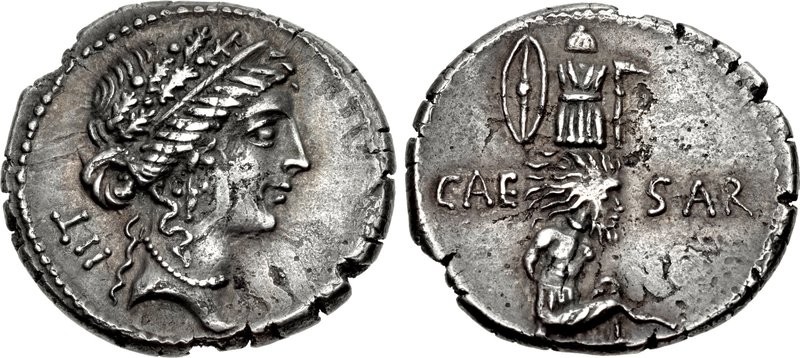Rome (denarius female head/trophy and captive) over uncertain type (Triton XVI, 8 Jan. 2013, 886)
From SILVER
Revision as of 12:39, 22 May 2024 by Vincent Vieux-Champagne (talk | contribs) (Created page with "{{Overstrike |Image overstriking coin=Triton_886.jpg |Image reference overstriking coin=https://www.acsearch.info/search.html?id=1482087 |Sale=Triton XVI, 8 Jan. 2013, 886 |Ob...")
LII | CAE SAR
Images
Overstriking coin

Triton_886.jpg [1]
Location/history
| Sale(s)Sale(s) ᵖ: | Triton XVI, 8 Jan. 2013, 886 | |
Overstriking coin
Description
| ObverseInscription or printing placed on the obverse.: | LII (Latin) Female head, right, wearing oak-wreath and diadem. Border of dots. | ReverseInscription or printing placed on the reverse.: | CAE SAR (Latin) Trophy with Gallic shield and carnyx, below, bearded captive seated with hands tied behind back. Border of dots |
Mint and issuing power
| MintIdentifies the place of manufacture or issue of a numismatic object.: | Rome | Ancient regionAncient region. | Latium | Modern countryModern country: Italy | AuthorityIdentifies the issuing power. The authority can be "pretended" when the name or the portrait of X is on the coin but he/she was not the issuing power. It can also be "uncertain" when there is no mention of X on the coin but he/she was the issuing power according to the historical sources: | Roman Republic, Julius Caesar (Roman general, statesman, Consul and Dictator Perpetuus, 100-44 BC) |
Chronology
| FromIdentifies the initial date in a range assigned in a numismatic context. toIdentifies the final date in a range assigned in a numismatic context.. | periodTime period of the numismatic object. |
Physical description
| MetalThe physical material (usually metal) from which an object is made.: | |||
References
| Coin referenceReference of the Coin: | Coin series referenceReference to coin series study: |
Overstruck type
Description
| ObverseInscription or printing placed on the obverse.: | ReverseInscription or printing placed on the reverse.: |
Mint and issuing power
| MintIdentifies the place of manufacture or issue of a numismatic object. ᵖ: | Ancient regionAncient region. ᵖ | Modern countryModern country: | AuthorityIdentifies the authority in whose name (explicitly or implicitly) a numismatic object was issued. ᵖ: |
Chronology
| FromIdentifies the initial date in a range assigned in a numismatic context. toIdentifies the final date in a range assigned in a numismatic context.. | periodTime period of the numismatic object. |
Physical description
References
| Coin type referenceReference to coin series study ᵖ: |
Additional data
| Frequency of overstrikesFrequency of overstrikes: | Level of confidenceLevel of confidence of the identification: | ||
| RemarksRemarks: | |||
References
- ^ Grueber, Herbert A. (1910), Coins of the Roman Republic in the British museum, Trustees of the British Museum Pubs., vol.3, pl.123
- ^ Sydenham, Edward Allen (1952), The Coinage of the Roman Republic, London, Spink & Son Ltd., lxix, 343 p., 30 pl.
- ^ Seaby, Herbert Allen (1967), Roman silver coins. Vol. 1, The Republic to Augustus, B.A. Seaby, Ltd, p.166
- ^ Crawford, Michael H. (1974), Roman Republican Coinage, Cambridge
- ^ Sear, David R. (1998), The history and coinage of the Roman Imperators 49-27 BC, Spink, p.xxxii, p.360